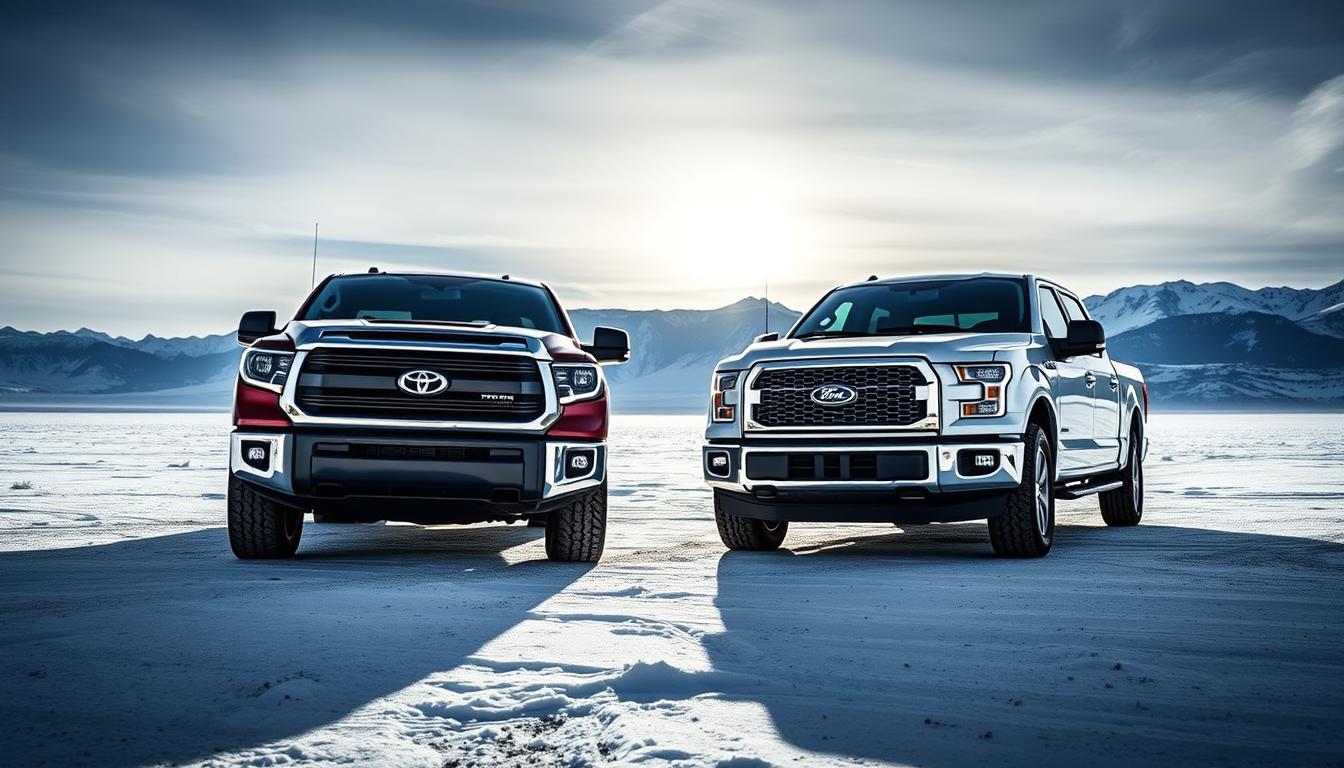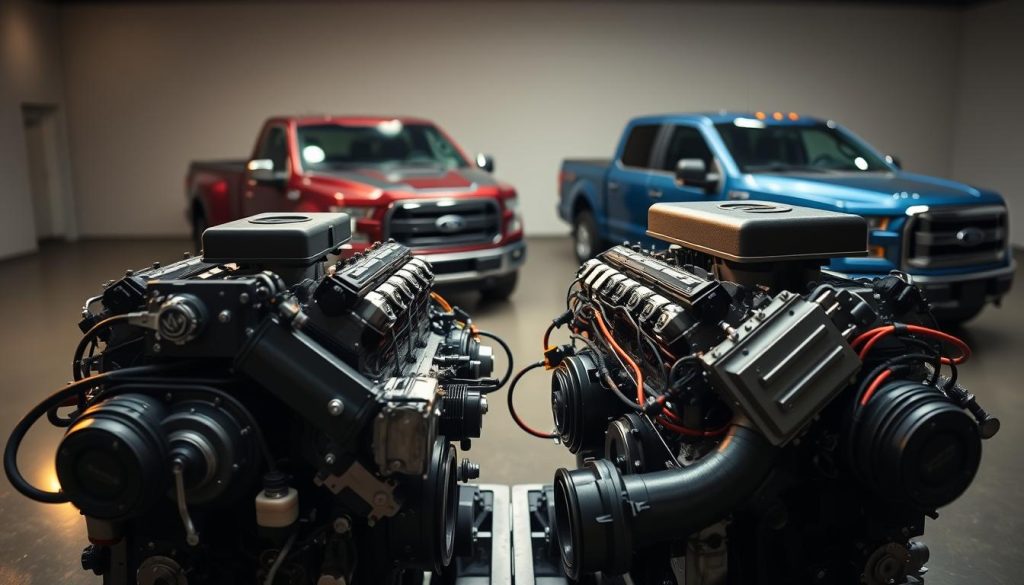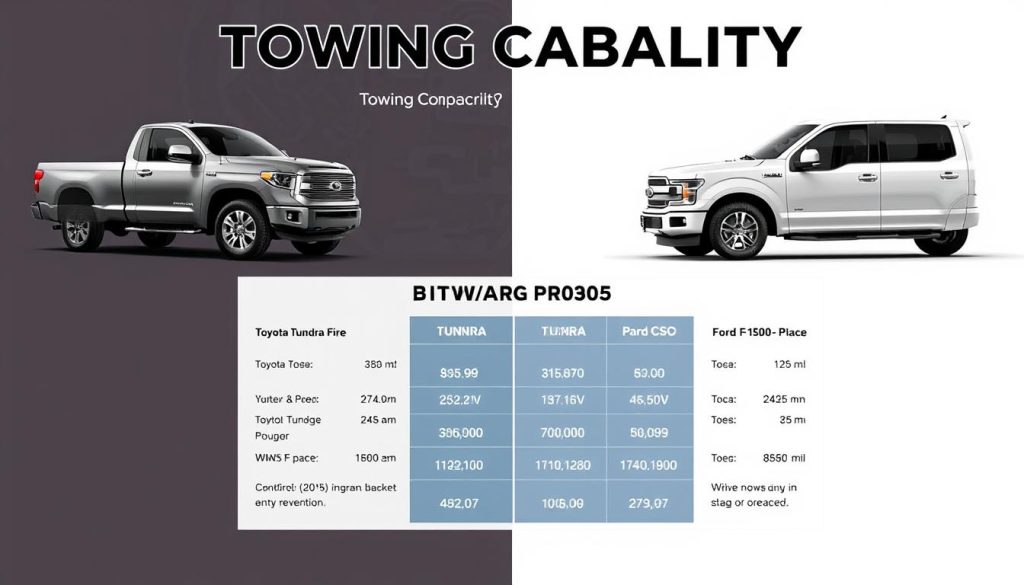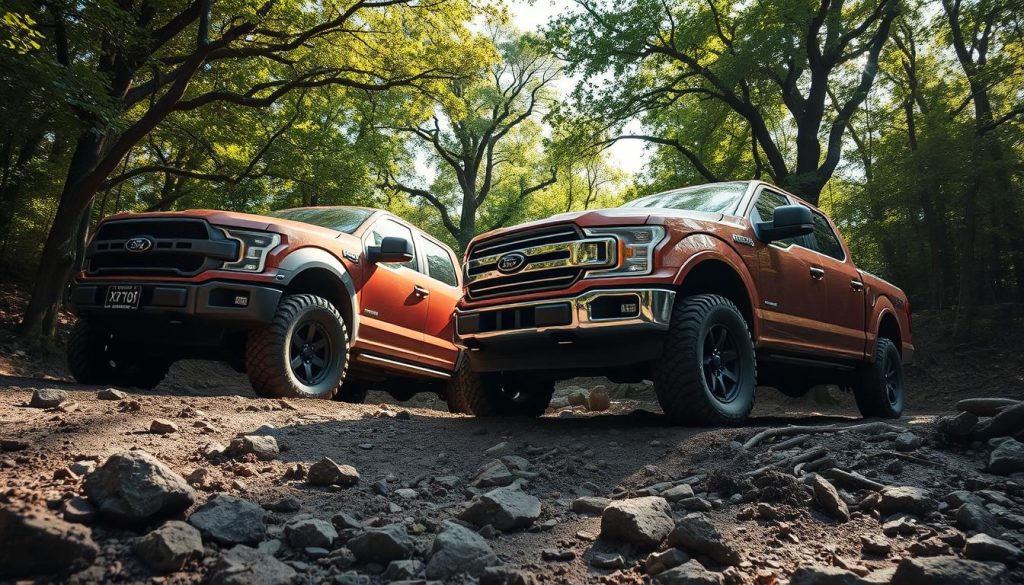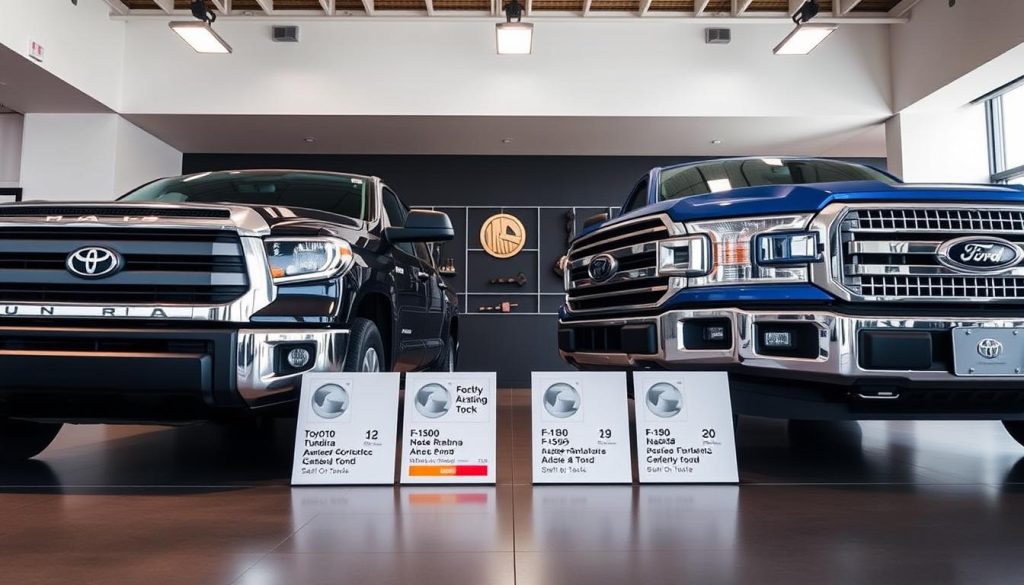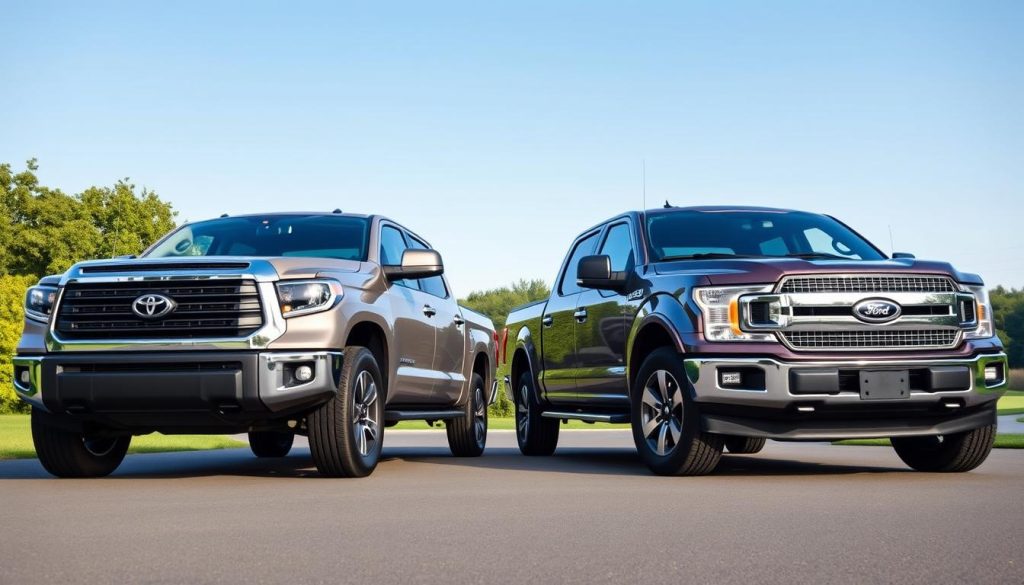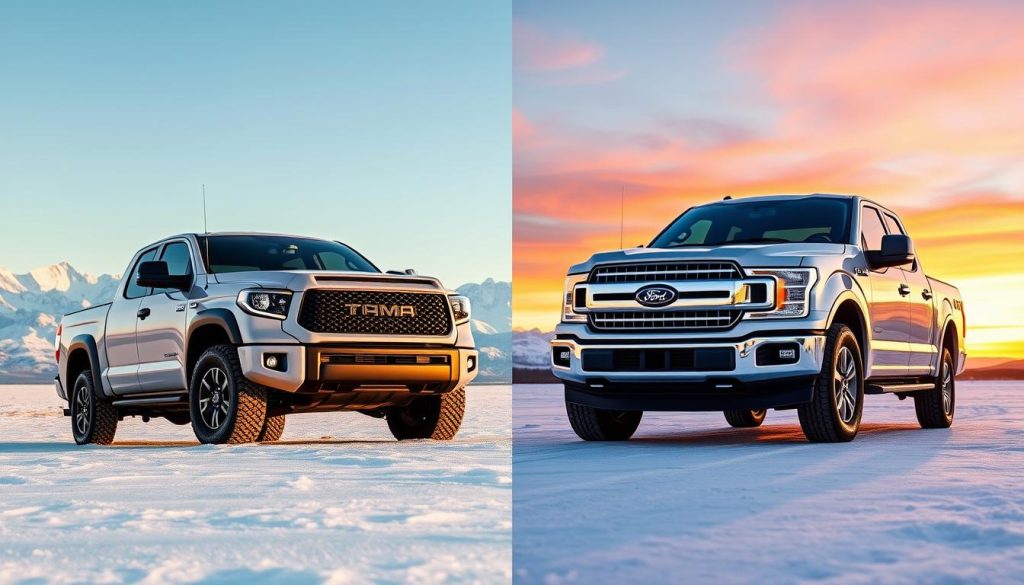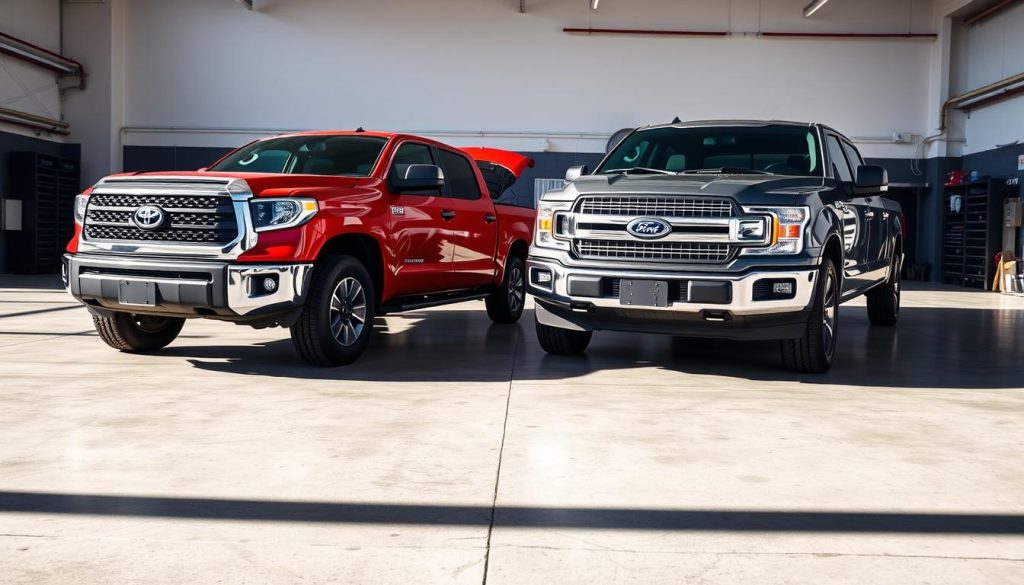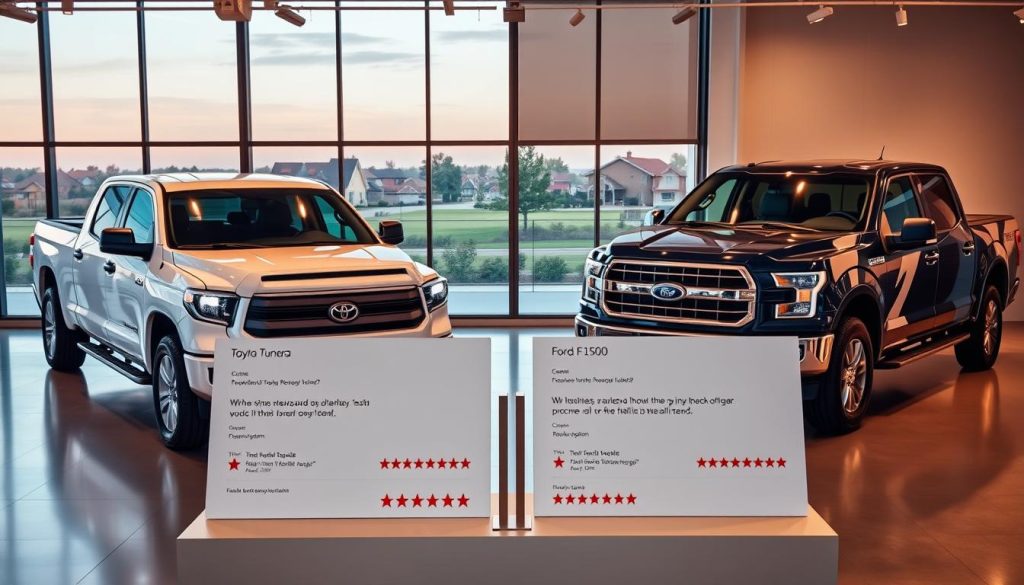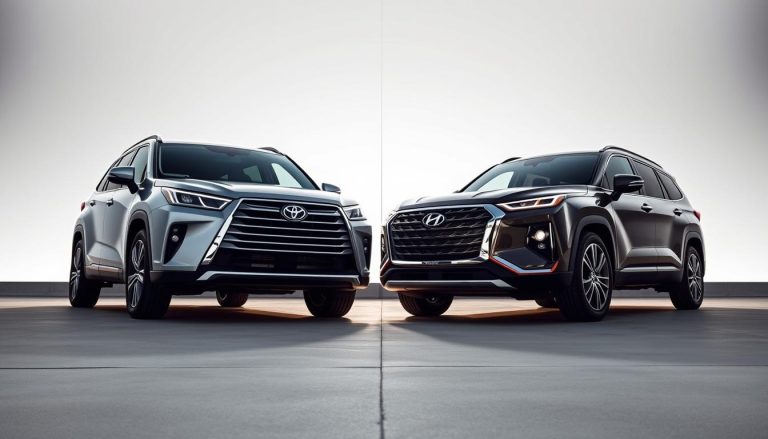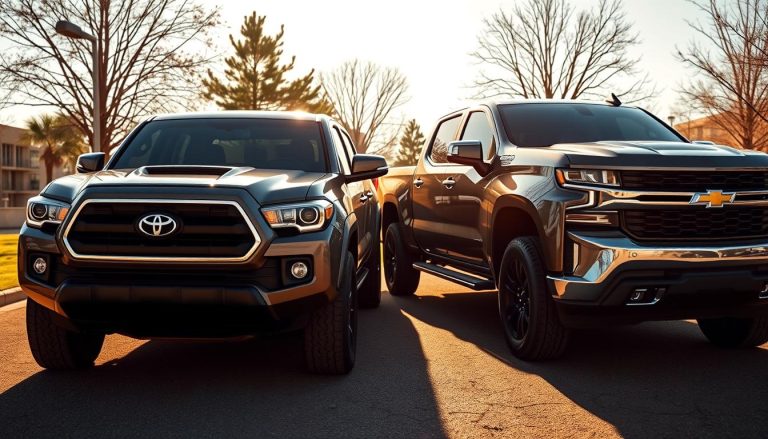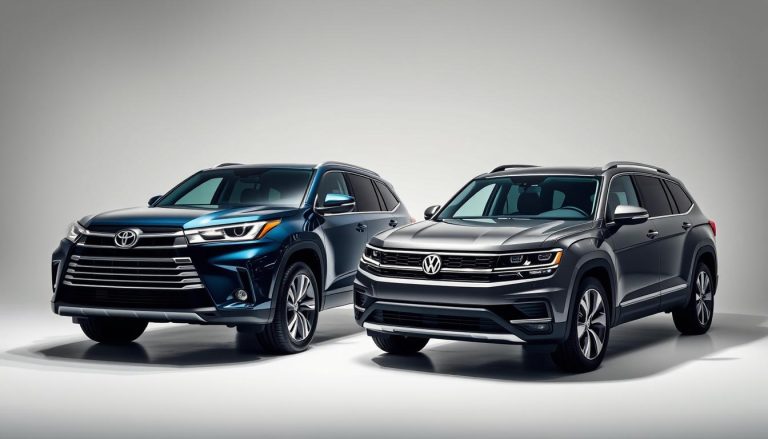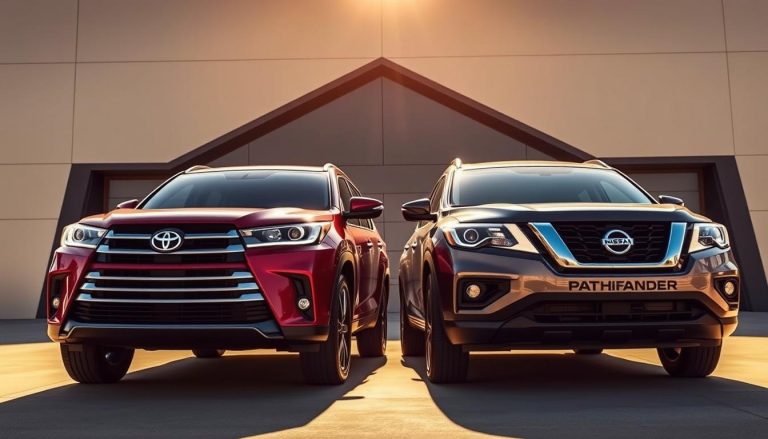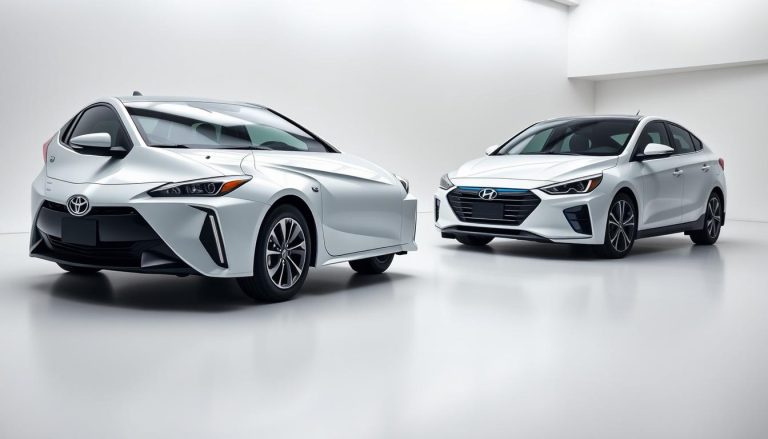Toyota Tundra vs F 150: Which Truck Leads the Pack?
Two giants stand out in the world of full-size pickup trucks: the Toyota Tundra and Ford F-150. These trucks are the top of the line, each with its own special features. They lead the way in the truck market.
People who love trucks and those who use them for work often argue over which one is better. The Tundra vs F 150 debate is not just about numbers. It’s about which truck fits your needs best, whether you’re a weekend adventurer or a hard worker.
We’ll look closely at how these trucks perform, their design, what they can do, and how they work in real life. If you need a reliable truck for work or a fun partner for adventures, this guide will help you choose.
Let’s examine every important detail of these amazing trucks. We’ll compare their strengths and see which one might be the best in the full-size pickup truck world.
A Legacy of Power: Introduction to Both Trucks
The world of full-size pickup trucks has been shaped by two iconic models: the Ford F-150 and Toyota Tundra. These vehicles are more than just cars. They show American innovation and top-notch automotive engineering.
The Ford F-150 is a true American legend, starting in 1948. It’s not just a truck; it’s the best-selling vehicle in America for years. Its lasting appeal comes from constant innovation and meeting customer needs.
Tracing the Truck Timeline
The Toyota Tundra joined the full-size truck scene in 1999. It was Toyota’s first big try in the American full-size pickup market. The Tundra brought Japanese engineering precision to a market dominated by domestic trucks.
- Ford F-150: Launched in 1948, became market leader
- Toyota Tundra: Introduced in 1999, challenging domestic truck makers
- Both trucks represent significant technological advancements
Each truck had its own strengths. The Ford F-150 was known for its rugged American design. The Toyota Tundra, on the other hand, was praised for its reliability and innovative manufacturing.
| Truck Model | Year Introduced | Market Impact |
|---|---|---|
| Ford F-150 | 1948 | Defined American truck segment |
| Toyota Tundra | 1999 | Brought global perspective to trucks |
The comparison between Ford F-150 and Toyota Tundra tells a story of automotive evolution. It shows how two different makers tackled the full-size pickup market with their own strategies and visions.
Engine Performance and Power Delivery
Truck lovers will find an exciting showdown between the Toyota Tundra and Ford F-150. Both trucks pack a punch, showing off their unique strengths. They compete fiercely in the full-size pickup market.
The Toyota Tundra boasts a 3.5L V6 twin-turbocharged engine. This engine is a powerhouse, delivering:
- 389 horsepower
- 479 lb-ft of torque
- Advanced twin-turbo technology
The Ford F-150, on the other hand, offers a variety of engines. It has everything from a 3.3L V6 to EcoBoost options. The F-150’s engines can produce:
- 290 to 450 horsepower
- 265 to 510 lb-ft of torque
- Multiple configuration options
Both trucks show off impressive performance. The Tundra’s twin-turbo engine gives steady power. The F-150, with its flexible engine lineup, meets different driving needs.
Performance isn’t just about numbers—it’s about how the power translates to real-world driving experience.
When choosing between these trucks, think about what you need. The Tundra’s engine is reliable and powerful. The F-150 lets you customize your truck’s performance.
Tundra vs F 150: Direct Performance Comparison
The battle between the Toyota Tundra and Ford F-150 is exciting. Both trucks offer impressive power and speed. They challenge drivers to see how fast they can go.
Engine performance is key when comparing the Tundra and F-150. Each truck has its own strengths. They meet different driving needs and tastes.
Acceleration Metrics Breakdown
Performance metrics show interesting facts about these trucks:
- The Toyota Tundra’s i-Force Max hybrid powertrain accelerates quickly.
- The Ford F-150 has various engine options for different performance levels.
- Both trucks can go from 0-60 mph in under 6 seconds.
| Performance Metric | Toyota Tundra | Ford F-150 |
|---|---|---|
| 0-60 mph Time | 5.7 seconds | 5.9 seconds |
| Horsepower Range | 348-437 hp | 290-450 hp |
| Transmission | 10-speed automatic | 10-speed automatic |
The comparison shows both trucks are very competitive. Drivers will enjoy quick acceleration and smooth power. It doesn’t matter which truck you choose.
Performance isn’t just about numbers—it’s about how the truck feels when you’re behind the wheel.
It’s important for buyers to test drive both trucks. This way, they can feel the unique engine characteristics and performance differences themselves.
Towing Capacity and Payload Capabilities
When choosing a truck, towing capacity and payload are key. The Ford F-150 and Toyota Tundra offer great options. Each meets different needs for truck lovers.
The Ford F-150 shines with its impressive stats. It can tow up to 14,000 lbs, perfect for heavy hauling. Its payload capacity is 3,325 lbs, ideal for carrying heavy tools.
The Toyota Tundra also has strong numbers. It can tow 12,000 lbs, a bit less than the F-150. But, its payload capacity of 1,940 lbs is enough for most users.
- Ford F-150 Maximum Towing Capacity: 14,000 lbs
- Ford F-150 Payload Capacity: 3,325 lbs
- Toyota Tundra Maximum Towing Capacity: 12,000 lbs
- Toyota Tundra Payload Capacity: 1,940 lbs
Knowing these specs helps buyers choose wisely. Towing capacity shows how much weight a truck can pull. Payload capacity is the max weight the truck can carry.
Real-world performance is important, but these numbers are a good starting point for picking a truck.
Interior Comfort and Technology Features
Full-size pickup trucks have changed a lot. They are now more than just work vehicles. The Toyota Tundra and Ford F-150 show off amazing interior features. These features make driving more comfortable and add cool tech.
Both trucks offer great interior experiences. They meet today’s driver needs. The cabins are a big step forward in car design. They mix function with luxury.
Sophisticated Cabin Design
When we look at the interiors of full-size pickup trucks, the F-150 and Tundra really stand out. They have different ways of making the inside comfy:
- Ford F-150 has optional massaging seats for the best comfort
- Tundra has a new interior design that’s easy to use
- Both have big touchscreen displays
- They use high-quality materials to make the inside look great
The tech features are also impressive:
- They have 12-inch central infotainment displays
- They make it easy to connect your phone
- There are lots of USB charging ports
- They offer wireless connectivity options
Drivers get to enjoy top-notch comfort and tech. It makes every drive feel like a luxury trip.
Exterior Design and Build Quality
The look of full-size trucks matters a lot. It affects how they look and how well they work. The Toyota Tundra and Ford F-150 show different ways to design trucks. These designs reflect their brands and how they think about building trucks.
The Ford F-150 is known for its aluminum body. This makes the truck lighter but just as strong. It also helps the truck use less fuel. The truck’s look, with its strong shape and clean lines, is a symbol of American truck style.
- Ford F-150 uses advanced aluminum-alloy body panels
- Toyota Tundra features a more aggressive modern styling
- Both trucks prioritize robust construction and visual appeal
The Toyota Tundra got a new look recently. It has a bold front and strong body lines. This design shows the truck’s power and ability. It’s made for those who want a truck that looks as tough as it is.
| Design Element | Toyota Tundra | Ford F-150 |
|---|---|---|
| Body Material | High-strength steel | Aluminum-alloy body |
| Styling Approach | Aggressive modern design | Classic American truck aesthetic |
| Signature Design Element | Bold front grille | Sculpted body panels |
Both the Toyota Tundra and Ford F-150 are built to last. They are made with care to handle tough jobs and different driving situations.
Hybrid Powertrain Options
Full-size pickup trucks are now using hybrid technology, thanks to Toyota and Ford. They are changing the game with their engine performance. Hybrid powertrains bring power and efficiency together for truck lovers.
Hybrid systems in full-size pickup trucks are changing what we expect from engines. They mix gasoline engines with electric motors. This combo gives trucks amazing abilities.
Comparing Cutting-Edge Hybrid Technologies
Toyota’s i-Force Max and Ford’s PowerBoost show two ways to make hybrid trucks. Each has its own benefits for better performance and fuel use.
| Feature | Toyota Tundra i-Force Max | Ford F-150 PowerBoost |
|---|---|---|
| Total Horsepower | 437 hp | 430 hp |
| Total Torque | 583 lb-ft | 570 lb-ft |
| Engine Type | Hybrid V6 | EcoBoost V6 Hybrid |
Hybrid powertrains offer many benefits:
- They use less fuel
- They have more torque
- They’re better for the environment
- They make more electrical power
Toyota and Ford have worked hard to make hybrid trucks. They keep the truck’s tough performance but add new tech.
Off-Road Capabilities and Features
Off-road capabilities are key for drivers who love adventure. The Toyota Tundra and Ford F-150 have amazing features for tackling tough terrains. They turn rough paths into fun playgrounds.
The Ford F-150 has several off-road packages for different landscapes. Drivers can pick from:
- FX4 Off-Road Package
- Tremor Model
- High-Performance Raptor Trim
Toyota’s Tundra also has special off-road features in its TRD lineup. It has advanced suspension systems for better performance on rough ground.
| Feature | Ford F-150 | Toyota Tundra |
|---|---|---|
| Off-Road Trims | FX4, Tremor, Raptor | TRD Off-Road, TRD Pro |
| Suspension System | Advanced Shock Absorbers | Bilstein Performance Shocks |
| Terrain Management | Multiple Drive Modes | Multi-Terrain Select |
Both trucks offer top-notch off-road tech. The Tundra’s Multi-Terrain Select and the F-150’s smart drive modes work great on rocky, muddy, or sandy grounds.
Safety Features and Ratings
When looking at full-size pickup trucks, safety is key. The Toyota Tundra and Ford F-150 focus on keeping drivers and passengers safe. They use advanced safety tech and strong structures.
Today’s trucks have more safety features than ever before. Both Toyota and Ford have worked hard to make their trucks safe. They aim to give families and workers peace of mind.
Comprehensive Safety Technologies
- Advanced driver assistance systems
- Collision mitigation technologies
- Adaptive cruise control
- Lane departure warnings
- Blind spot monitoring
The National Highway Traffic Safety Administration (NHTSA) tests these trucks thoroughly. They check how well the trucks do in crashes.
| Safety Metric | Toyota Tundra | Ford F-150 |
|---|---|---|
| Overall Safety Rating | 5/5 Stars | 5/5 Stars |
| Frontal Crash Test | Excellent | Excellent |
| Side Impact Protection | Superior | Superior |
Safety innovations are changing the truck world. Toyota and Ford are leading the way in keeping drivers and passengers safe.
Reliability and Long-Term Value
When you buy a full-size truck, reliability is key. The Toyota Tundra and Ford F-150 both offer great long-term value. They stand out in the truck market.
The Toyota Tundra is known for its durability. It has few maintenance issues and performs well for years. Its engineering aims for longevity, making it reliable in surveys.
- Average ownership cost remains low for Toyota Tundra
- Resale value typically maintains strong market positioning
- Proven track record of minimal mechanical failures
The Ford F-150 also shines in reliability. Ford’s long truck-building history has improved its manufacturing. The F-150’s aluminum body is lighter but strong.
Important reliability points for both trucks are:
- Quality of manufacturing materials
- Comprehensive warranty coverage
- Performance under diverse driving conditions
Potential truck buyers should consider not just initial purchase price, but total cost of ownership. Both the Toyota Tundra and Ford F-150 show strong value retention. They are smart long-term investments for dependable full-size trucks.
Price Comparison and Trim Levels
When looking at full-size pickup trucks like the Tundra vs F 150, price is key. The cost and trim levels greatly affect a truck’s value.
The Ford F-150 starts lower than the Toyota Tundra. It has many trim levels. This makes it flexible for different needs and budgets.
Exploring Base Model Features
Both trucks have great entry-level options:
- Ford F-150 XL starts around $33,695
- Toyota Tundra SR starts around $36,965
These base models come with important features. The F-150 has:
- Standard 3.3L V6 engine
- Basic connectivity features
- Practical work-oriented configuration
The Tundra’s base model offers:
- More robust standard safety features
- Enhanced infotainment system
- Slightly more powerful standard powertrain
For those wanting premium experiences, both trucks have high-end trims. These offer advanced tech and luxury.
Choosing between the Tundra vs F 150 depends on individual preferences, budget, and specific performance requirements.
Maintenance Costs and Warranty Coverage
Buying a truck is more than just the price. Maintenance costs and warranty coverage are key to keeping your truck’s value up. The Toyota Tundra and Ford F-150 have different ways to protect your investment.
Toyota Tundra owners get a strong warranty that shows the company trusts their truck. The warranty includes:
- 36,000-mile basic warranty
- 60,000-mile powertrain coverage
- 5-year roadside assistance
Ford F-150 also offers a solid warranty. It covers maintenance needs just like Toyota’s warranty.
“Preventative maintenance is the key to long-term truck performance and value retention.” – Automotive Experts
The Toyota Tundra usually costs less for annual service. Ford F-150 might be a bit pricier because of its advanced tech.
| Maintenance Aspect | Toyota Tundra | Ford F-150 |
|---|---|---|
| Average Annual Service Cost | $589 | $675 |
| Recommended Service Intervals | Every 5,000 miles | Every 5,000-7,500 miles |
Both trucks have scheduled maintenance plans. These plans help you plan for the future. Buyers should think about these details when choosing a truck.
Customer Satisfaction and Reviews
When comparing the Toyota Tundra and Ford F-150, we see two passionate groups. Each has its own views on these famous trucks. People share their real-life experiences, pointing out what they like and what they don’t.
Customers have clear choices based on what they need. The debate between the Tundra and F-150 often focuses on a few key points:
- Reliability and durability
- Performance under demanding conditions
- Long-term ownership experience
- Cost of maintenance
Toyota Tundra owners often talk about its robust build quality and reliable performance. On the other hand, Ford F-150 fans love its versatility and tech features.
| Satisfaction Category | Toyota Tundra | Ford F-150 |
|---|---|---|
| Reliability Rating | 4.6/5 | 4.4/5 |
| Performance Satisfaction | 4.5/5 | 4.7/5 |
| Technology Features | 4.3/5 | 4.8/5 |
Both trucks get high marks from customers, according to reports and surveys. It’s clear that what each person wants plays a big part in their choice.
“Choosing between the Tundra and F-150 comes down to personal needs and driving expectations.” – Automotive Expert Review
Conclusion
Choosing between the Toyota Tundra and Ford F-150 means looking at what you need in a full-size pickup truck. Both trucks offer great performance, new tech, and strong features for different driving needs.
The Tundra vs F 150 comparison shows each truck’s strong points. The Ford F-150 leads in payload and towing. But the Toyota Tundra is more reliable and has hybrid powertrain options. Think about what you’ll use the truck for most.
These trucks are top examples of car engineering. Your choice will depend on what you like, your budget, and what you need from a truck. Both the Toyota Tundra and Ford F-150 have features that make them great choices in the market.
Choosing either truck means you’re getting quality, performance, and value. Take your time to test drive, compare, and think about your needs. This will help you make the best choice for your lifestyle.
FAQ
What are the main differences between the Toyota Tundra and Ford F-150?
The Toyota Tundra and Ford F-150 differ in engine options, towing capacity, and interior tech. The Ford F-150 has more engine choices and can tow more. The Toyota Tundra is known for its reliability and solid build.
Which truck has better towing capacity?
The Ford F-150 can tow up to 14,000 pounds, while the Toyota Tundra can tow about 12,000 pounds. But, the exact towing capacity depends on the truck’s trim and setup.
Are hybrid options available for both trucks?
Yes, both trucks have hybrid models. The Toyota Tundra has the i-Force Max hybrid, and Ford has the PowerBoost hybrid F-150. Both hybrids offer better fuel efficiency and more power than their gas engines.
Which truck is more reliable?
Toyota is known for reliability, and the Tundra usually scores higher in reliability tests. But, the Ford F-150 has also gotten better and offers a long warranty.
What are the starting prices for these trucks?
Prices start around ,000 for the Toyota Tundra and a bit lower for the Ford F-150. High-end trims can go over ,000 for both.
Which truck is better for off-road use?
Both trucks are great off-road. The Toyota Tundra’s TRD Pro and the Ford F-150’s Tremor and Raptor are top choices. They have special suspension, all-terrain tires, and more ground clearance.
How do the interior technologies compare?
Both trucks have advanced infotainment systems with big screens, smartphone integration, and driver-assist tech. The Ford F-150 might have more tech, but the Tundra’s interior is modern and easy to use.
What are the fuel efficiency ratings?
Fuel efficiency depends on the engine. But, hybrids like the Ford F-150 PowerBoost and Toyota Tundra i-Force Max save more fuel than gas engines.
Which truck has better safety features?
Both trucks have full safety packages. Toyota’s Safety Sense and Ford’s Co-Pilot360 offer similar features like adaptive cruise control and automatic emergency braking. Both trucks do well in crash tests.
Can these trucks be used for daily driving and heavy-duty work?
Yes! Both trucks are great for daily driving and heavy-duty tasks. They have comfortable interiors for daily use and strong capabilities for work and fun.

